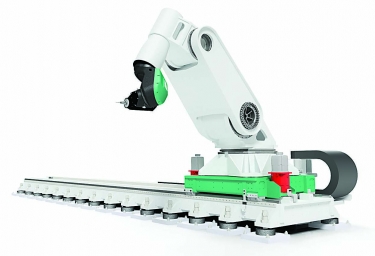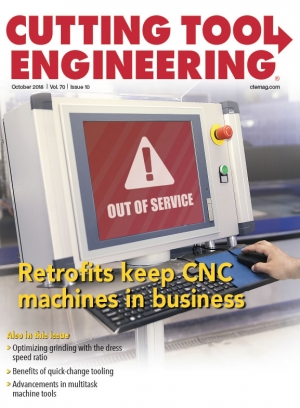Researchers in Germany think they’re close to developing a more economical alternative to machine tools for many milling applications.
The alternative is a robot arm for precision machining. Conventional industrial robots can be used for milling but are no match for machine tools when it comes to precision. Primarily because of the gear units, robots have relatively low stiffness, which translates into increased tool deflection during milling operations. As a result, robot milling is unsuitable for applications that demand tight production tolerances.

Flexmatik is a milling-capable industrial robot arm being developed by three Fraunhofer institutes. Image courtesy of Fraunhofer Institute for Manufacturing Technology and Advanced Materials
Researchers at three institutes of the Fraunhofer Society in Germany aim to change that. The researchers joined forces to produce a robot capable of precisely milling various materials, including aluminum, carbon fiber-reinforced plastic and steel. The goal is to complete a functional prototype of a robot, dubbed Flexmatik, by the end of 2018.
The Flexmatik design is based on a conventional 6-axis industrial robot arm equipped at the end with a milling machine electrospindle. The spindle can be fitted with a milling, drilling or grinding tool, which the robot arm positions anywhere within Flexmatik’s workspace to machine a workpiece. Machining processes will be run by a conventional CNC for machine tools.
If the researchers succeed, however, Flexmatik’s milling capabilities will go beyond what’s possible for a conventional robot arm. “Our goal is to achieve part accuracy for milling operations of approximately ±0.1mm for the first part,” said Sascha Reinkober, Flexmatik project manager and head of the manufacturing technologies department of the Fraunhofer Institute for Production Systems and Design Technology in Berlin. (The other Fraunhofer entities involved in the project are the Institute for Structural Durability and System Reliability and the Institute for Manufacturing Technology and Advanced Materials.) Flexmatik will be capable of achieving the target accuracy right from the beginning of a machining process, with no calibration or process adjustments necessary, Reinkober explained.
He said conventional industrial robots are incapable of precision milling because they aren’t stiff enough to accurately follow a programmed toolpath when acted upon by forces generated by the machining process. To keep Flexmatik from straying too much from its programmed path, the robot’s axes will be equipped with what Fraunhofer researchers call “partially direct drives.” Reinkober described a partially direct drive as a patent-pending hybrid. On one hand, it includes a direct drive that has the stiffness to handle high-process loads. On the other hand, it has a conventional motor-and-gear drive system that allows the robot to make fast, smooth movements during machining.
Flexmatik will also feature an active vibration control system and a climate control strategy that the researchers say minimizes machining imprecision due to temperature fluctuations. System simulations performed by the researchers indicate that the Flexmatik design, which includes these features and partially direct drives, can achieve a ±0.1mm tolerance starting with the first component.
To make the design more versatile, the researchers mounted the robot arm on a linear rail, giving Flexmatik a workspace comparable to that of a large portal milling machine. Even without the rail, the workspace of an industrial robot with a 2m-long arm is much larger than that of most machine tools, Reinkober noted.
Perhaps Flexmatik’s greatest advantage will be the savings it offers. The researchers believe that the system could cost as much as 90 percent less than a conventional milling machine and consume at least 90 percent less energy. Also, unlike a portal milling machine, Flexmatik does not require a special foundation, reducing construction costs and increasing setup flexibility.
The researchers think Flexmatik will be able to handle jobs in nearly all sectors in which machine tools are used. But the goal is not to consign machine tools to the scrap heap of history.
“Machining processes like milling, drilling or grinding can have accuracy [requirements] of 1µm or less,” Reinkober noted. “Even if you optimize the robot, you will never be able to reach the accuracies of a machine tool.”
Many machining applications, however, don’t require such high accuracy, he added. These include chamfering and deburring, as well as machining very large and additive-manufactured parts. In these areas, the machine tool may soon have to cede turf to a money- and energy-saving challenger.
Related Glossary Terms
- calibration
calibration
Checking measuring instruments and devices against a master set to ensure that, over time, they have remained dimensionally stable and nominally accurate.
- chamfering
chamfering
Machining a bevel on a workpiece or tool; improves a tool’s entrance into the cut.
- computer numerical control ( CNC)
computer numerical control ( CNC)
Microprocessor-based controller dedicated to a machine tool that permits the creation or modification of parts. Programmed numerical control activates the machine’s servos and spindle drives and controls the various machining operations. See DNC, direct numerical control; NC, numerical control.
- conventional milling ( up milling)
conventional milling ( up milling)
Cutter rotation is opposite that of the feed at the point of contact. Chips are cut at minimal thickness at the initial engagement of the cutter’s teeth with the workpiece and increase to a maximum thickness at the end of engagement. See climb milling.
- gang cutting ( milling)
gang cutting ( milling)
Machining with several cutters mounted on a single arbor, generally for simultaneous cutting.
- grinding
grinding
Machining operation in which material is removed from the workpiece by a powered abrasive wheel, stone, belt, paste, sheet, compound, slurry, etc. Takes various forms: surface grinding (creates flat and/or squared surfaces); cylindrical grinding (for external cylindrical and tapered shapes, fillets, undercuts, etc.); centerless grinding; chamfering; thread and form grinding; tool and cutter grinding; offhand grinding; lapping and polishing (grinding with extremely fine grits to create ultrasmooth surfaces); honing; and disc grinding.
- industrial robot
industrial robot
Robot designed for industrial use. Primarily used as a material-handling device but also used for changing tools, assembling parts, and manipulating special tools and measuring devices. Depending on design, an industrial robot can be programmed to perform a task by means of a controller, or it can be “walked” through the required movements by utilizing a digitizing system that translates movements into commands that the robot can be “taught.” See robot; teaching pendant.
- milling
milling
Machining operation in which metal or other material is removed by applying power to a rotating cutter. In vertical milling, the cutting tool is mounted vertically on the spindle. In horizontal milling, the cutting tool is mounted horizontally, either directly on the spindle or on an arbor. Horizontal milling is further broken down into conventional milling, where the cutter rotates opposite the direction of feed, or “up” into the workpiece; and climb milling, where the cutter rotates in the direction of feed, or “down” into the workpiece. Milling operations include plane or surface milling, endmilling, facemilling, angle milling, form milling and profiling.
- milling machine ( mill)
milling machine ( mill)
Runs endmills and arbor-mounted milling cutters. Features include a head with a spindle that drives the cutters; a column, knee and table that provide motion in the three Cartesian axes; and a base that supports the components and houses the cutting-fluid pump and reservoir. The work is mounted on the table and fed into the rotating cutter or endmill to accomplish the milling steps; vertical milling machines also feed endmills into the work by means of a spindle-mounted quill. Models range from small manual machines to big bed-type and duplex mills. All take one of three basic forms: vertical, horizontal or convertible horizontal/vertical. Vertical machines may be knee-type (the table is mounted on a knee that can be elevated) or bed-type (the table is securely supported and only moves horizontally). In general, horizontal machines are bigger and more powerful, while vertical machines are lighter but more versatile and easier to set up and operate.
- precision machining ( precision measurement)
precision machining ( precision measurement)
Machining and measuring to exacting standards. Four basic considerations are: dimensions, or geometrical characteristics such as lengths, angles and diameters of which the sizes are numerically specified; limits, or the maximum and minimum sizes permissible for a specified dimension; tolerances, or the total permissible variations in size; and allowances, or the prescribed differences in dimensions between mating parts.
- stiffness
stiffness
1. Ability of a material or part to resist elastic deflection. 2. The rate of stress with respect to strain; the greater the stress required to produce a given strain, the stiffer the material is said to be. See dynamic stiffness; static stiffness.
- tolerance
tolerance
Minimum and maximum amount a workpiece dimension is allowed to vary from a set standard and still be acceptable.
- toolpath( cutter path)
toolpath( cutter path)
2-D or 3-D path generated by program code or a CAM system and followed by tool when machining a part.









